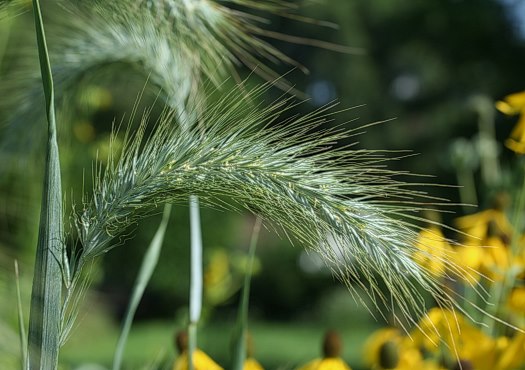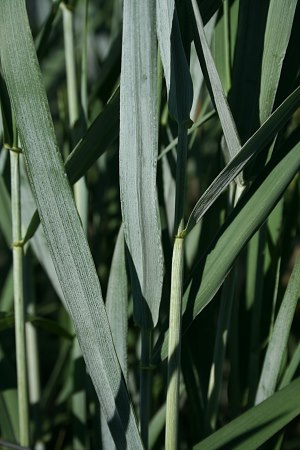Description: During the late spring and summer, this perennial grass is tufted at the base, producing unbranched culms about 3-5' tall. Each culm has about 8 alternate leaves that are distributed throughout its length; the lower leaves often become withered before commencement of the blooming period. From fall to spring, this grass produces clumps of low basal leaves up to 1' tall that are semi-evergreen. Each culm is light green, terete, and slightly glaucous; it is mostly hidden by the sheaths. The blades of the alternate leaves are up to 13" long and 2/3" (15 mm.) across; they are ascending to spreading, hairless, and widest toward the middle. The upper surface of each blade is green, while the lower surface is blue and glaucous. The sheaths of the alternate leaves are mostly blue and glaucous, although the lower sheaths may be somewhat green; they are hairless, open, and longer than than the internodal areas of the culm. Each ligule consists of a stiff short membrane that soon turns brown. The nodes of the culm are slightly swollen.

Each culm
terminates in a nodding spike about 5-9" long and 1½" across. This
spike consists of a dense arrangement of slightly spreading spikelets
and their awns; it has a blue and a glaucous appearance. Each spikelet
has a pair of glumes below and 3-6 lemmas above, forming a V-shape; the
spikelets occur in groups of 2 or more. Each glume is about 2.0–2.5 cm.
long (including its awn) and 1.25 mm. across; it is blue-glaucous,
linear in shape, and slightly ciliate along the margins with short
stiff hairs. Each lemma is about 1.0–1.5 cm. long (excluding its awn),
2.25 mm. across, and having an awn about 2.0–4.0 cm. long; it is
blue-glaucous, finely pubescent on the outer surface, and narrowly
linear-lanceolate in shape. Each lemma encloses a palea (a membrane
that surrounds the ovary/grain) that is 8.5–13.0 mm. in length. The
blooming period occurs during mid- to late summer. The culms and their
spikes turn tan during the fall, at which time the awns curve outward.
Disarticulation of the spikelets is above the glumes. The large grains
are 5.0–7.0 mm. long, 1.5–2.0 mm. across, somewhat flattened, and
narrowly oblongoid-ellipsoid in shape. The root system is fibrous.
Cultivation:
The preference is full to partial sun and moist to dry conditions. This
grass will adapt to practically any kind of soil, including those
containing loam, clay, gravel, or sand. This robust grass readily
reseeds itself and can be aggressive in some situations. If the seeds
are planted during the spring, it can develop culms with flowering
spikes during the summer or fall of the same year.

Range & Habitat:
The native Canada Wild Rye is found in every county of Illinois and it
is quite
common (see Distribution
Map). However, the blue-glaucous form of this species, f.
glaucifolius, as described here, is less common than the
typical form with green foliage. Habitats include black soil prairies
and sand prairies, typical savannas and sandy savannas, woodland edges,
limestone glades, thinly-wooded rocky bluffs, dunes along Lake
Michigan, riverbanks in sunny areas, gravelly areas along railroads,
and fallow fields. The blue-glaucous form of Canada Wild Rye prefers
habitats that are more dry and sunny than the typical form, although it
can be found in many of the same habitats as the typical form. Some
specimens of Canada Wild Rye have blue-green foliage that is
intermediate between the typical and blue-glaucous forms. Canada Wild
Rye is often used in prairie restorations.
Faunal Associations:
Insects that feed on this species include the leafhoppers Commellus
comma, Dorycephalus platyrhynchus, and Laevicephalus
orientalis; also the larvae of the leaf beetle Diabrotica
barberi, which feed on the roots. The young foliage is
palatable to the Cottontail Rabbit and various hoofed herbivores,
including cattle and horses. However, the awned seedheads of mature
plants can pierce the tender mouthparts of the latter animals and cause
problems in their digestive tracts. Birds apparently make little use of
the seeds.
Photographic Location:
The webmaster's wildflower garden in Urbana, Illinois. The original
seeds were collected from a colony of plants that were growing along an
abandoned railroad in Champaign County, Illinois.
Comments:
In bright sunlight, the blue-glaucous form of Canada Wild Rye has a
shiny metallic appearance. It is one of my favorite grass species.
Canada Wild Rye can be distinguished from other grass species by its
large and distinctive spikes. While other Elymus spp.
(Wild Ryes) have large spikes, they are often erect and the awns of
their spikes remain straight at maturity (rather than curving outward).
A species with nodding spikes, Elymus villosus
(Silky Wild Rye), has spikelets with only 1-2 lemmas each, while the
spikelets of Canada Wild Rye have 3-6 lemmas each. This provides the
spikes of the latter species with a more stout appearance. Canada Wild
Rye also has longer paleas (8.5 mm. or more) than Silky Wild Rye and
other Wild Ryes. Another common name of Elymus canadensis
is Nodding Wild Rye. The large seeds were used as a food source by
Amerindians.